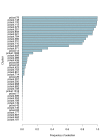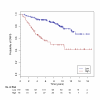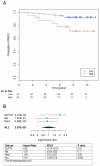Predicting prognosis using molecular profiling in estrogen receptor-positive breast cancer treated with tamoxifen
- PMID: 18498629
- PMCID: PMC2423197
- DOI: 10.1186/1471-2164-9-239
Predicting prognosis using molecular profiling in estrogen receptor-positive breast cancer treated with tamoxifen
Abstract
Background: Estrogen receptor positive (ER+) breast cancers (BC) are heterogeneous with regard to their clinical behavior and response to therapies. The ER is currently the best predictor of response to the anti-estrogen agent tamoxifen, yet up to 30-40% of ER+BC will relapse despite tamoxifen treatment. New prognostic biomarkers and further biological understanding of tamoxifen resistance are required. We used gene expression profiling to develop an outcome-based predictor using a training set of 255 ER+ BC samples from women treated with adjuvant tamoxifen monotherapy. We used clusters of highly correlated genes to develop our predictor to facilitate both signature stability and biological interpretation. Independent validation was performed using 362 tamoxifen-treated ER+ BC samples obtained from multiple institutions and treated with tamoxifen only in the adjuvant and metastatic settings.
Results: We developed a gene classifier consisting of 181 genes belonging to 13 biological clusters. In the independent set of adjuvantly-treated samples, it was able to define two distinct prognostic groups (HR 2.01 95%CI: 1.29-3.13; p = 0.002). Six of the 13 gene clusters represented pathways involved in cell cycle and proliferation. In 112 metastatic breast cancer patients treated with tamoxifen, one of the classifier components suggesting a cellular inflammatory mechanism was significantly predictive of response.
Conclusion: We have developed a gene classifier that can predict clinical outcome in tamoxifen-treated ER+ BC patients. Whilst our study emphasizes the important role of proliferation genes in prognosis, our approach proposes other genes and pathways that may elucidate further mechanisms that influence clinical outcome and prediction of response to tamoxifen.
Figures




References
-
- Sorlie T, Perou CM, Tibshirani R, Aas T, Geisler S, Johnsen H, Hastie T, Eisen MB, van de Rijn M, Jeffrey SS, Thorsen T, Quist H, Matese JC, Brown PO, Botstein D, Eystein Lonning P, Borresen-Dale AL. Gene expression patterns of breast carcinomas distinguish tumor subclasses with clinical implications. Proc Natl Acad Sci U S A. 2001;98:10869–10874. doi: 10.1073/pnas.191367098. - DOI - PMC - PubMed
-
- Sotiriou C, Neo SY, McShane LM, Korn EL, Long PM, Jazaeri A, Martiat P, Fox SB, Harris AL, Liu ET. Breast cancer classification and prognosis based on gene expression profiles from a population-based study. Proc Natl Acad Sci U S A. 2003;100:10393–10398. doi: 10.1073/pnas.1732912100. - DOI - PMC - PubMed
-
- Sotiriou C, Wirapati P, Loi S, Harris A, Fox S, Smeds J, Nordgren H, Farmer P, Praz V, Haibe-Kains B, Desmedt C, Larsimont D, Cardoso F, Peterse H, Nuyten D, Buyse M, Van de Vijver MJ, Bergh J, Piccart M, Delorenzi M. Gene expression profiling in breast cancer: understanding the molecular basis of histologic grade to improve prognosis. J Natl Cancer Inst. 2006;98:262–272. - PubMed
Publication types
MeSH terms
Substances
LinkOut - more resources
Full Text Sources
Other Literature Sources
Medical
Molecular Biology Databases

